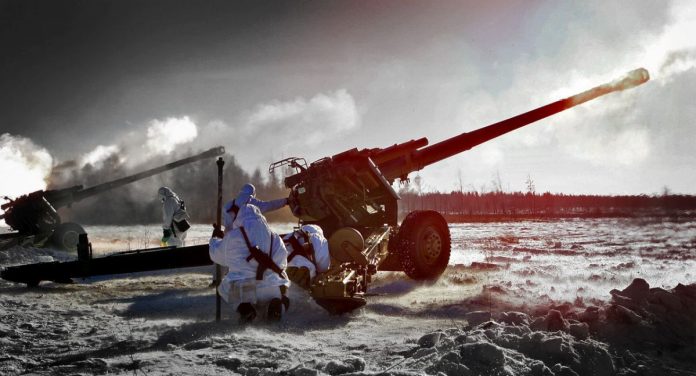
An artillery today is very difficult to talk. If in a simple way, ie Shirokorad, be they, who are interested in artillery, well aware of the names of other Russian and foreign historians artillery. This is particularly. Review things to do easier, and the articles are good exactly, that push readers to independent search for material, to their own conclusions. In the end - to form their own view on the subject of the article.
But it so happened, that several readers have raised quite an interesting question about the heavy guns in the Russian Army before and during World War I..
How could it happen, that Russia is "missed the" increased importance of it at the beginning of the heavy guns 20 century? And it turned out, that Soviet Russia was among the world leaders in the production of such weapons before the Second World?
We will try to answer both of these questions, especially, that the answers are fraught with several interesting points.
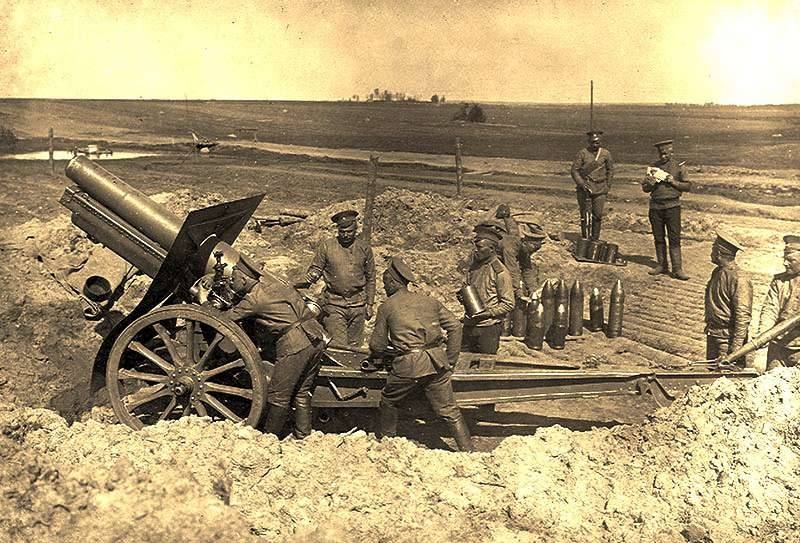
In fact, everything was very, very natural!
To understand, What is the Russian artillery, must be clear structure of artillery units and subunits. AT 1910 the organization of the Russian artillery was adopted. so, artillery division:
— field, designed for fighting ground (field) troops. Includes easy and horse, mountain and horse mountain, howitzer and field heavy.
— the fortress, intended for the defense of fortresses (land and coastal), ports and raids.
— siege, It is designed to break down the castle walls, destruction of enemy fortifications and support the offensive ground forces.
How view, the presence of heavy weapons, It seems to be necessary. Even in the category of field guns.
But why, then, we met a war practically unarmed, in this sense? agree, 122-mm field howitzer sample 1909 of the year (firing range of up to 7 700 m), 152-mm field howitzer sample 1910 and, the 152 mm cannon sample siege 1910 of the year, for the army of a country, as Russia, not enough. Furthermore, if you follow the "rule of law", three guns caliber greater 120 mm, only 152 mm can be "legitimate" attributed to heavy artillery.
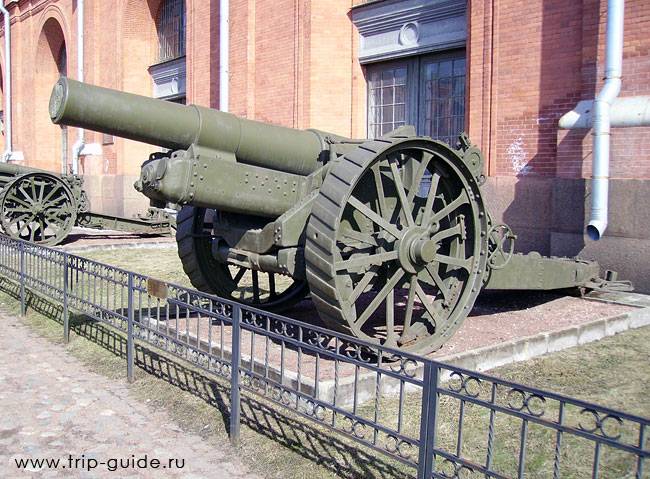 Siege gun 152mm
Siege gun 152mm
Guilty of, heavy artillery that had disappeared in the early centuries of the Russian army, It must be regarded as the generals of the General Staff. That the General Staff actively developed the idea of a quick, mobile warfare. But this is not a Russian invention. This is the doctrine of the French war, for which the presence of a large number of heavy weapons do not necessarily. And even harmful because of difficulties in maneuvering and changing positions.
It is worth recalling, France in the early 20 century was a military fashion trendsetter, France and the Russian Empire to ally. So - all natural.
It is this concept, as well as clear the backlog of Russian heavy artillery from modern samples in other armies of the world, It led to, that existed then siege artillery was disbanded.
The guns of the first half 19 century went to the warehouse, or fortress. It was believed, that will be enough 152-mm guns for new war. The larger caliber recycled or sent to storage.
Instead of siege artillery were heavy army artillery units. But ... Modern guns was not for these groups!
At the beginning of the war (1 August 1914 of the year) Russian army had 7 088 guns. Of these howitzers - 512 pcs. In addition to the listed heavy guns were other developments.
152-mm siege weapon (aforementioned) — 1 thing.
203-mm howitzer Countdown. 1913 g. — 1 thing.
prototypes. It is safe to assume, that at the beginning of the war in the army with heavy weapons was only 152 mm howitzer.
Even more depressing picture we see, if you look at the documents the production of ammunition. At the 107 mm cannon and howitzer 152 mm was produced by 1 000 pieces of shells per gun. 48% the desired volume. But, plan for the production of shells for the 76-mm gun was exceeded in more than 2 fold.
We can not ignore and the organization of Russian Ground Forces. It is from the point of view of artillery.
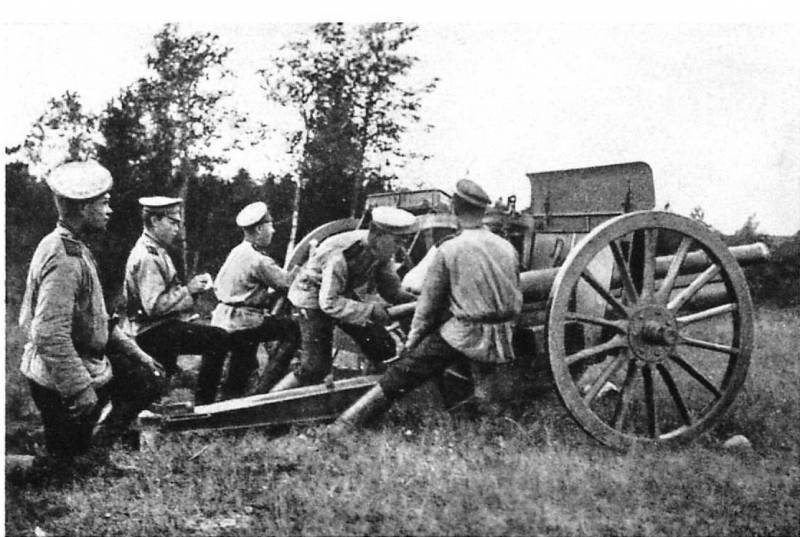
The infantry division was part of an artillery brigade composed of two divisions, each of which consisted of 3 batteries 76 mm light guns. 48 guns in the gang. chief of artillery, the main organizers of the action of artillery in combat, It was not included in all states. arco (two infantry divisions) Division had 122mm light howitzers (12 guns).
By simple mathematical operations, we get terrible figures security big guns of the Russian army. Army Corps had just 108 guns! Of them 12 howitzer. And no heavy!
Even a simple mathematical calculation striking power Army Corps shows, that really this compound does not have the necessary, not only defensive, but also an offensive force. And immediately flashed another important miscalculation of our generals. 12 howitzers on the body suggests an underestimation of tools to conduct hinged fire. Lightweight Howitzer there, and the mortars did not exist!
so, transition to trench warfare defects Russian army showed. Tools for grazing fire could not provide suppression of enemy infantry and weapons in the presence of advanced positioning system. Defense in depth perfectly defended by guns.
Come to understand, that the mortars and howitzers simply vital. And, tools needed increased capacity. The enemy not only uses natural obstacles, but also builds major civil engineering constructions.
So, on the second line of defense the Germans built to shelter the infantry bunkers deep to 15(!) m! Gun or light howitzer then just powerless. But heavy howitzers or mortars quite cope.
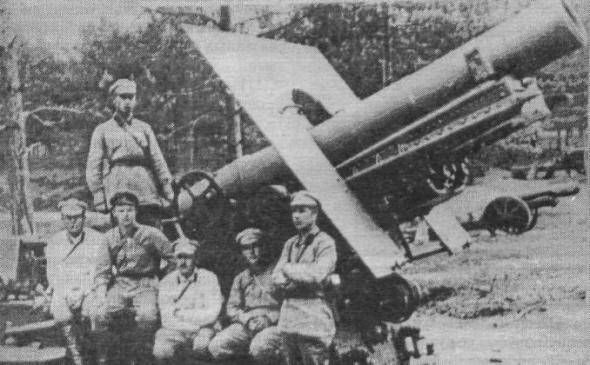 203-mm howitzer samples 1913 of the year
203-mm howitzer samples 1913 of the year
Here emerges the answer to an important question, even today,. universal tool! we, when they wrote about the universal instruments, We believe in the need for such instruments. But! Not one "universal" will not be able to exceed the "narrow specialist". This means, We need all kinds of artillery.
The command of the Russian army quickly learned the lessons of the first months of the war. AT 1915-16 years, on the basis of combat experience, several artillery systems have been developed in Russia - 203 mm howitzer sample 1915 of the year, 280-mm mortar sample 1914- 1915 s and 305 mm howitzer sample 1916 of the year. The truth is released, there were very few.
By January 1917 the General Staff of the Russian army made heavy artillery of special purpose (tAON), or "48th Corps". The structure consisted of Thaon 6 teams with 388 instruments, the most powerful of which were new, 120-mm long-range guns, 152-mm coastal guns Kane, 245-mm cannon coast, 152 and 203mm. howitzers and the new 305-mm howitzers Obukhov plant sample 1915 of the year, 280-mm mortars.
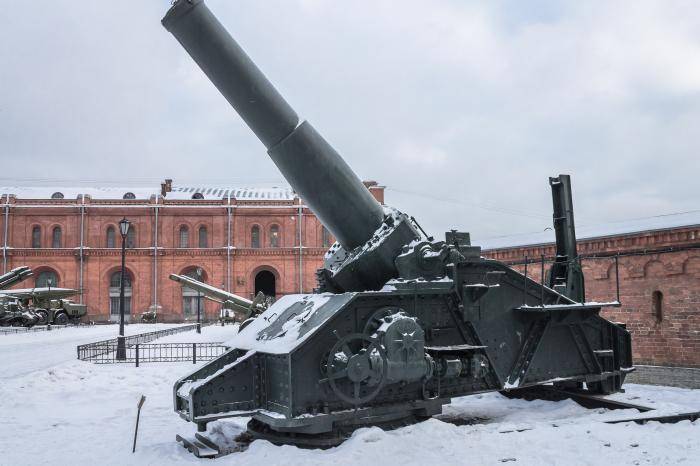 305-mm howitzer samples 1915 of the year
305-mm howitzer samples 1915 of the year
The First World War showed the commanders and military engineers to the necessary and sufficient artillery ratio, smoke and howitzers (mortir). AT 1917 year 5 had guns 4 gaubitsы! for comparison, at the beginning of the war there were other figures. Two guns odna howitzer.
And in general,, If we talk specifically about the heavy artillery, at the end of the war, the Russian army had in its composition 1430 heavy weapons. for comparison: Germans had 7862 guns. Even fighting on two fronts, indicative figure.
That this war has made the most important factor of any artillery victory. God of war! And he pushed the Soviet engineers to actively work on the design and creation of a truly 'divine' weapons.
Understanding the importance of heavy artillery and the ability to create it - things are really different. But in a new country is well aware. Exactly the same had to do with the tanks, and with the aircraft - can not create itself - Copy.
With guns were easier. There were Russian (quite good) model, There were a huge number of imported systems. Good, zatrofeili a lot of them, How to capture on the fields of the First World, and during the intervention, as well as due to the fact, that yesterday's allies in the Entente actively supplied military equipment Yudenitch, Kolchak, Denikin and other.
It was officially purchased guns, as, eg, Here is a 114-mm howitzer from the company "Vickers". On it, we'll separately, as well as all instruments, a caliber of 120 mm and above.
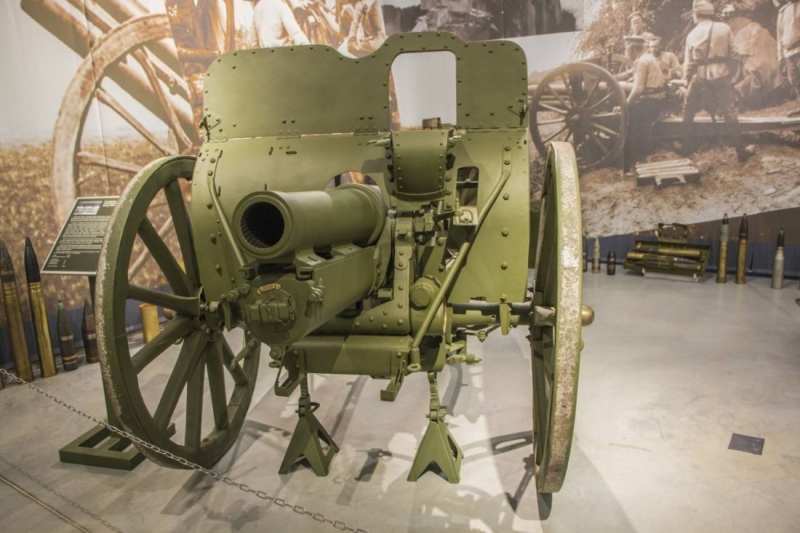 114,3-quick-mm howitzer "Vickers" sample 1910 of the year
114,3-quick-mm howitzer "Vickers" sample 1910 of the year
Besides, in the Red Army were howitzers, are on opposite sides of the front: Krupp and Schneider. Krupp production model took up the Putilov Works, a production model of the company Schneider - Motovilihisky and Obukhov plants. And two of these tools have become a base for the subsequent development of heavy artillery.
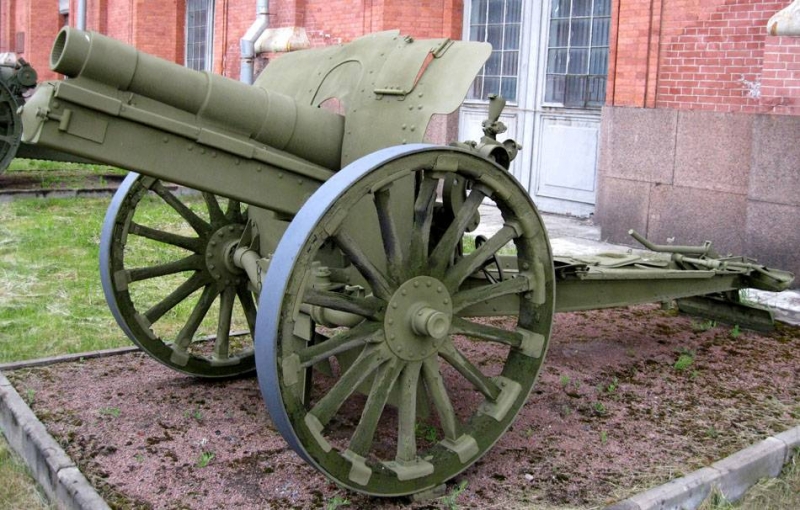 122-mm howitzer samples 1909 of the year
122-mm howitzer samples 1909 of the year
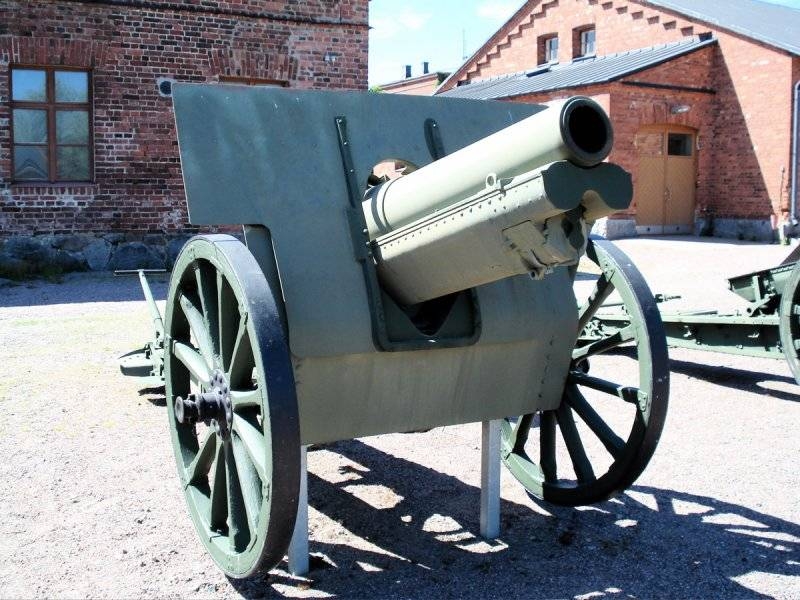 152-mm howitzer samples 1910 of the year
152-mm howitzer samples 1910 of the year
In the Soviet Union understood: without bread does, without guns, too. Therefore, putting an end to economic issues, it was Stalin who took up defensive positions. 1930-The year can be called the starting point, because in this year we began a huge transformation in the Army and Navy.
I touched it and artillery. "Old woman" were upgraded -gaubitsy. But that was only the beginning. Englishwoman, Germans and French have become parties to the experiments of the Soviet gunsmiths, whose purpose was to obtain a suitable and modern artillery systems. AND, need to say, often accompanied by the success of our engineers.
We will describe in detail and in color the history and life of almost all our guns of large caliber. History of the creation of each - a private detective, because the authors did not assume such general. A sort of "Rubik's Cube" by artillery developers. But interesting.
meanwhile, while in KB was working on the design of new tools, Artillery structure RKKA undergone very noticeable change.
Paradox, probably, but - for the better. Also in 1922 year began military reform in the army, which to 1930 He was given the first fruits and the results.
reforms and the executor of the author was M. AT. Frunze, human, which could be not only an outstanding military leader, but also the practice of building the army. Alas, His early death is not allowed to do this. Work on the reform of the Red Army, started Frunze, completed by. E. Voroshilov.
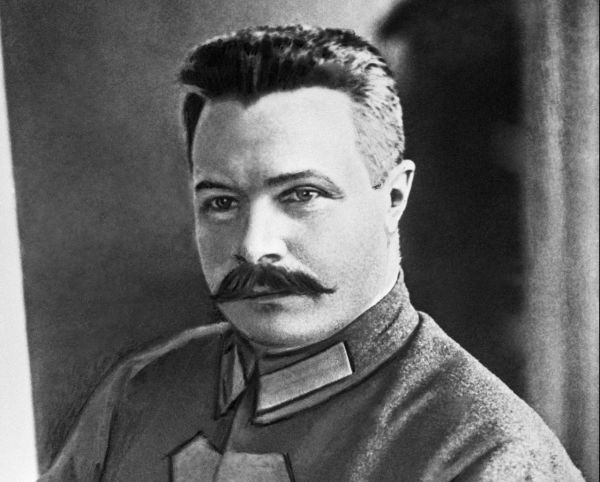 M. AT. Frunze
M. AT. Frunze
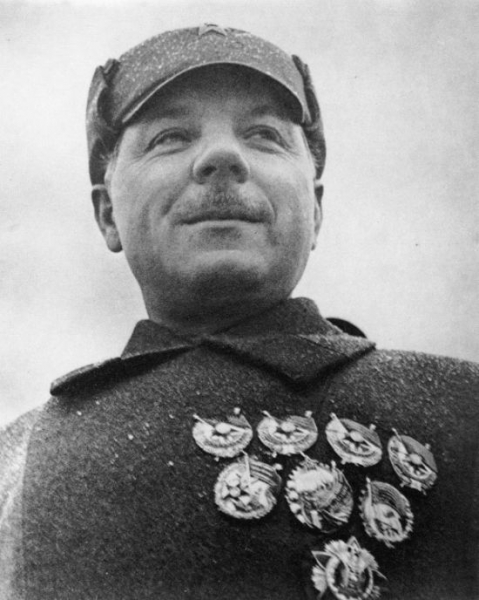 TO. E. Voroshilov
TO. E. Voroshilov
We have already talked about the "polkovushke", 76-mm regimental gun, that appeared in 1927 year. epochal gun, and not only outstanding performance characteristics. Yes, Rifle Weapon 6,7 km, though, that weighed only 740 kg. Light weight tool-making is very mobile, that is for the benefit and made it possible to work closely with the artillery units Infantry Regiment.
by the way, at the same time in the armies of other countries regimental artillery did not exist, and support issues were dealt with allocation from the divisional artillery infantry support weapons. So in this issue, Specialists of the Red Army wiped his nose Evropam. AND, The Great Patriotic War only confirmed the correctness of the way the organization of the artillery regiment.
AT 1923 this year the unit was created, as the Rifle Corps. Simultaneously the task of introduction of the corps artillery of the Red Army has been solved. Each Rifle Corps received in its composition in addition to the artillery regiment, Heavy Artillery Division, armed with guns 107 mm and 152 mm howitzers. Subsequently, the artillery corps was reformed in the heavy artillery regiments.
AT 1924 she received a new organization divisional artillery. At the beginning of the Infantry Division Artillery Regiment was introduced dvuhdivizionnogo composition, in Russian army, then the number of divisions in the regiment was increased to three. When the same three batteries in the division. Arming divisional artillery were 76mm cannon sample 1902 year and 122-mm howitzer sample 1910 of the year. The number of guns has increased to 54 units 76mm guns and 18 howitzer unit.
The organizational structure of the artillery of the Red Army at the beginning of the Great Patriotic War will be considered separately, because it is quite a serious investigation, especially in comparison with artillery Vermahta.
In general, today to speak of the lag of the Red Army from the European armies in the 30s of the last century. This is true for some types of troops, but the sad list of artillery is not exactly part. If we consider the large-caliber artillery closely, field, antitank, antiaircraft, here it will reveal a lot of nuances, is evidence, that the artillery of the Red Army was not just at a certain height, but at least not inferior to the leading armies of the world. And in many respects superior to.
Further materials will be devoted to this topic, To prove this statement. God of War in the Red Army was.











